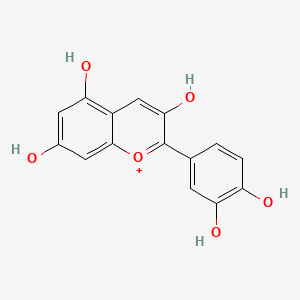| MeSH term | MeSH ID | Detail |
|---|---|---|
| Colonic Neoplasms | D003110 | 161 associated lipids |
| Edema | D004487 | 152 associated lipids |
| Glioma | D005910 | 112 associated lipids |
| Tooth Discoloration | D014075 | 7 associated lipids |
| Psoriasis | D011565 | 47 associated lipids |
| Wound Infection | D014946 | 12 associated lipids |
| Nerve Degeneration | D009410 | 53 associated lipids |
Cyanidin
Cyanidin is a lipid of Polyketides (PK) class. Cyanidin is associated with abnormalities such as Consumption-archaic term for TB, furuncle, Obesity, Cardiovascular Diseases and Endothelial dysfunction. The involved functions are known as anthocyanin biosynthetic process, Regulation, flavonoid biosynthetic process, Anabolism and anthocyanin metabolic process. Cyanidin often locates in Body tissue, integral to membrane, Autonomic nervous system, Blood and Tissue membrane. The associated genes with Cyanidin are anthocyanidin synthase, SLC2A8 gene, EPB41L2 gene, NKS1 gene and GLUCOSIDASE. The related lipids are Butanols. The related experimental models are Knock-out.
Cross Reference
Introduction
To understand associated biological information of Cyanidin, we collected biological information of abnormalities, associated pathways, cellular/molecular locations, biological functions, related genes/proteins, lipids and common seen animal/experimental models with organized paragraphs from literatures.
What diseases are associated with Cyanidin?
Cyanidin is suspected in Obesity, Chronic Disease, Diabetes Mellitus, Non-Insulin-Dependent, Cardiovascular Diseases, Heart Diseases, Inflammatory disorder and other diseases in descending order of the highest number of associated sentences.
Related references are mostly published in these journals:
| Disease | Cross reference | Weighted score | Related literature |
|---|
Possible diseases from mapped MeSH terms on references
We collected disease MeSH terms mapped to the references associated with Cyanidin
PubChem Associated disorders and diseases
What pathways are associated with Cyanidin
There are no associated biomedical information in the current reference collection.
PubChem Biomolecular Interactions and Pathways
Link to PubChem Biomolecular Interactions and PathwaysWhat cellular locations are associated with Cyanidin?
Visualization in cellular structure
Associated locations are in red color. Not associated locations are in black.
Related references are published most in these journals:
| Location | Cross reference | Weighted score | Related literatures |
|---|
What functions are associated with Cyanidin?
Related references are published most in these journals:
| Function | Cross reference | Weighted score | Related literatures |
|---|
What lipids are associated with Cyanidin?
Related references are published most in these journals:
| Lipid concept | Cross reference | Weighted score | Related literatures |
|---|
What genes are associated with Cyanidin?
Related references are published most in these journals:
| Gene | Cross reference | Weighted score | Related literatures |
|---|
What common seen animal models are associated with Cyanidin?
Knock-out
Knock-out are used in the study 'MATE2 mediates vacuolar sequestration of flavonoid glycosides and glycoside malonates in Medicago truncatula.' (Zhao J et al., 2011) and Knock-out are used in the study 'How can research on plants contribute to promoting human health?' (Martin C et al., 2011).
Disease model
Disease model are used in the study 'How can research on plants contribute to promoting human health?' (Martin C et al., 2011).
Animal Disease Models
Animal Disease Models are used in the study 'How can research on plants contribute to promoting human health?' (Martin C et al., 2011).
Related references are published most in these journals:
| Model | Cross reference | Weighted score | Related literatures |
|---|
NCBI Entrez Crosslinks
All references with Cyanidin
Download all related citations| Authors | Title | Published | Journal | PubMed Link |
|---|---|---|---|---|
| Arya A et al. | Chloroform Fraction of Centratherum anthelminticum (L.) Seed Inhibits Tumor Necrosis Factor Alpha and Exhibits Pleotropic Bioactivities: Inhibitory Role in Human Tumor Cells. | 2012 | Evid Based Complement Alternat Med | pmid:22474512 |
| Abe LT et al. | Potential dietary sources of ellagic acid and other antioxidants among fruits consumed in Brazil: jabuticaba (Myrciaria jaboticaba (Vell.) Berg). | 2012 | J. Sci. Food Agric. | pmid:22173652 |
| Luo X et al. | Cyanidin-3-glucoside suppresses TNF-α-induced cell proliferation through the repression of Nox activator 1 in mouse vascular smooth muscle cells: involvement of the STAT3 signaling. | 2012 | Mol. Cell. Biochem. | pmid:22120492 |
| Kovinich N et al. | Identification of two anthocyanidin reductase genes and three red-brown soybean accessions with reduced anthocyanidin reductase 1 mRNA, activity, and seed coat proanthocyanidin amounts. | 2012 | J. Agric. Food Chem. | pmid:22107112 |
| Hall D et al. | Molecular cloning and biochemical characterization of the UDP-glucose: flavonoid 3-O-glucosyltransferase from Concord grape (Vitis labrusca). | 2012 | Phytochemistry | pmid:22098678 |
| Jang HH et al. | Black rice (Oryza sativa L.) extract attenuates hepatic steatosis in C57BL/6 J mice fed a high-fat diet via fatty acid oxidation. | 2012 | Nutr Metab (Lond) | pmid:22458550 |
| Payyavula RS et al. | Differential effects of environment on potato phenylpropanoid and carotenoid expression. | 2012 | BMC Plant Biol. | pmid:22429339 |
| Aqil F et al. | Antioxidant and antiproliferative activities of anthocyanin/ellagitannin-enriched extracts from Syzygium cumini L. (Jamun, the Indian Blackberry). | 2012 | Nutr Cancer | pmid:22420901 |
| Zhang X et al. | Characterisation of anthocyanidin reductase from Shuchazao green tea. | 2012 | J. Sci. Food Agric. | pmid:22173936 |
| Duchnowicz P et al. | Hypolipidemic and antioxidant effects of hydroxycinnamic acids, quercetin, and cyanidin 3-glucoside in hypercholesterolemic erythrocytes (in vitro study). | 2012 | Eur J Nutr | pmid:21755326 |
